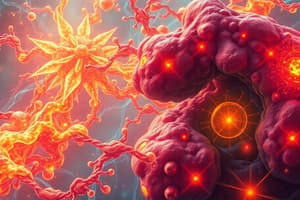Podcast
Questions and Answers
Which enzyme deficiency is one of the reasons for sudden infant death syndrome?
Which enzyme deficiency is one of the reasons for sudden infant death syndrome?
- Propionyl-CoA carboxylase
- Carnitine palmitoyltransferase I
- Acyl-CoA synthetase
- Acyl-CoA dehydrogenase (correct)
What is the most common inborn error of fatty acid oxidation?
What is the most common inborn error of fatty acid oxidation?
- Propionyl-CoA carboxylase deficiency
- Carnitine palmitoyltransferase I deficiency
- Acyl-CoA synthetase deficiency
- Medium-chain fatty acyl CoA dehydrogenase (MCAD) deficiency (correct)
Which enzyme deficiency can cause a decrease in fatty acid oxidation and severe hypoglycemia?
Which enzyme deficiency can cause a decrease in fatty acid oxidation and severe hypoglycemia?
- Medium-chain acyl-CoA dehydrogenase (correct)
- Propionyl-CoA carboxylase
- Carnitine acyltransferase I
- Acetyl-CoA carboxylase
Where are ketone bodies synthesized?
Where are ketone bodies synthesized?
During which period are ketone bodies produced in the liver?
During which period are ketone bodies produced in the liver?
Which tissue uses ketone bodies as an energy source?
Which tissue uses ketone bodies as an energy source?
What is the fate of ketone bodies in extrahepatic tissues?
What is the fate of ketone bodies in extrahepatic tissues?
Flashcards are hidden until you start studying
Study Notes
Fatty Acid Oxidation
- Carnitine shuttle: transports fatty acyl CoA into the mitochondrial matrix, where fatty acid oxidation takes place.
- Fatty acyl CoA is converted to fatty acyl carnitine by carnitine palmitoyltransferase I, which is inhibited by malonyl-CoA.
- Short- and medium-chain fatty acids (less than 12 carbons) enter the mitochondria without the aid of carnitine or CPT system.
β-Oxidation
- Sequence of 4 reactions that result in shortening by two carbons.
- Oxidation of a molecule of palmitoyl CoA to CO2 and H2O produces 8 acetyl CoA, 7 NADH, and 7 FADH2.
- Activation of fatty acid requires 2 ATP, but produces only 2 ATP.
- Oxidation of fatty acids with an odd number of carbons requires biotin.
Ketone Body Synthesis
- Takes place in liver mitochondria from acetyl CoA.
- Ketone bodies are: acetoacetate, β-hydroxybutyrate, and acetone (a non-metabolized side product).
- Acetoacetate and β-hydroxybutyrate are transported in blood to peripheral tissues, where they can be reconverted to acetyl CoA and oxidized by TCA.
Characteristics of Ketone Bodies
- Soluble in aqueous solution.
- Produced in liver during periods when the amount of acetyl CoA present exceeds the oxidative capacity of liver.
- Used by extrahepatic tissues.
Regulation of Cholesterol Synthesis
- HMG CoA reductase is the rate-limiting enzyme in cholesterol synthesis.
- When sterol levels are low, increased synthesis of HMG CoA reductase occurs.
- Insulin favors up-regulation of HMG CoA reductase gene expression, while glucagon has the opposite effect.
- Statins (e.g., atorvastatin, fluvastatin) are competitive inhibitors of HMG CoA reductase used in cholesterol therapy.
Degradation of Cholesterol
- Ring structure cannot be metabolized.
- Sterol nucleus is eliminated by conversion to bile acids and bile salts.
- Bile acids are amphipathic, acting as emulsifying agents in the intestines, helping pancreatic digestive enzymes.
Bile Acid Synthesis
- Takes place in the liver by a multistep, multiorganelle pathway.
- Bile acids are synthesized from cholesterol, and their structure is important for their function.
Medium-Chain Fatty Acyl CoA Dehydrogenase (MCAD) Deficiency
- Autosomal recessive disorder, the most common inborn error of FA oxidation.
- Causes decrease in FA oxidation and severe hypoglycemia.
- Infants are particularly affected, as milk contains primarily medium-chain fatty acids.
- MCAD deficiency can cause sudden infant death syndrome and Reye syndrome.
Studying That Suits You
Use AI to generate personalized quizzes and flashcards to suit your learning preferences.



